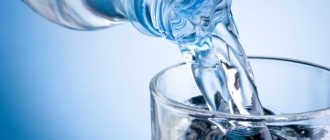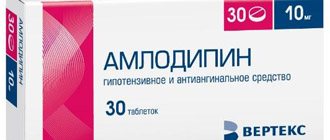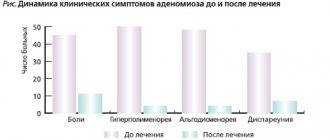Furagin-Aktifur
Suction
After taking the drug orally, furazidin is absorbed in the small intestine by passive diffusion. Absorption of nitrofurans from the distal segment of the small intestine exceeds absorption from the proximal and medial segments by 2 and 4 times, respectively (should be taken into account during the simultaneous treatment of urogenital infections and diseases of the gastrointestinal tract, including chronic enteritis). Nitrofurans are poorly absorbed in the colon.
Being a mixture of sodium furazidin and basic magnesium carbonate, Furagin-Actifur when administered orally has a higher bioavailability than simple furazidin (after taking the Furagin-Actifur capsule in the acidic environment of the stomach, the conversion of sodium furazidin into poorly soluble furazidin does not occur).
Distribution
Furazidin is distributed evenly in the body. The high content of the active substance in the lymph is clinically important (it delays the spread of infection along the lymphatic tract). In bile its concentration is several times higher than in serum, and in cerebrospinal fluid it is several times lower than in serum. In saliva, the content of furazidin is 30% of its concentration in serum. The concentration of furazidin in the blood and tissues is relatively small, which is associated with its rapid release, while the concentration in the urine is much higher than in the blood. The maximum concentration in blood plasma lasts from 3 to 7 or 8 hours; furazidin is detected in urine 3-4 hours after application.
Metabolism
Furazidine is slightly biotransformed (less than 10% of the administered dose); with a decrease in renal excretory function, the metabolic rate increases.
Removal
Unlike nitrofurantoin, the urine pH does not change after taking furazidine. 4 hours after taking the drug, the concentration of furazidine in the urine significantly exceeds the concentration that is formed after taking the same dose of nitrofurantoin. Excreted through the kidneys by glomerular filtration and tubular secretion (85%), partially undergoes reverse reabsorption in the tubules. At low concentrations of furazidin in the urine, the process of filtration and secretion predominates; at high concentrations, secretion decreases and reabsorption increases. Furazidine, being a weak acid, does not dissociate in acidic urine and undergoes intense reabsorption, which can enhance the development of systemic side effects. When the urine becomes alkaline, the excretion of furazidine increases.
Furagin tablets 50 mg No. 10x3
Name
Furagin tablet 50mg No. 10x3
Main active ingredient
Furazidin
Release form
Pills
Compound
Active ingredient: furagin. Each tablet contains 50 mg furagin. Excipients: modified corn starch, lactose monohydrate, sugar, polysorbate 80 (Tween-80), stearic acid.
Dosage
50mg
Pharmacological properties
Pharmacodynamics
Furagin is an antibacterial agent with a bacteriostatic effect, effective against both gram-positive (Staphylococcus epidermidis, Staphylococcus aureus, Staphylococcus faecalis) and gram-negative (Enterobacteriaceae - Escherichia coli, Klebsiella spp, Salmonella, Shygella, Proteus, Enterobacter, etc.) bacteria. The drug acts on staphylococci and other pathogenic strains of microorganisms that are resistant to sulfonamides and antibiotics. Resistance of microorganisms to furagin develops slowly and does not reach a high degree. The minimum inhibitory concentration of a drug in the treatment of urinary tract infections ranges from 0.7 mg/l to 20 mg/l. Pseudomonas aeruginosa is resistant to the drug. Nitrofurans inhibit the enzyme systems of microorganisms, as well as other biochemical processes in the bacterial cell, causing the destruction of its cytoplasmic membrane and cell membrane. As a result of the action of nitrofurans, microorganisms release fewer toxins, which improves the general condition of the patient even before the pronounced suppression of the microflora.
Pharmacokinetics
Absorption Furagin is well absorbed from the gastrointestinal tract. Absorption of the drug mainly occurs from the distal small intestine by passive diffusion. Absorption from the distal small intestine exceeds absorption from the proximal small intestine by 4 and 2 times, respectively. This must be taken into account when simultaneously treating urogenital infections and diseases of the gastrointestinal tract (chronic enteritis). Furagin binds to blood plasma proteins. After a single dose of 200 mg, the maximum concentration of the active substance is achieved in the blood plasma after 30 minutes, remains at this level for 1 hour, then slowly decreases. Bacteriostatic concentration in blood plasma persists for 8-12 hours. Metabolism/elimination 10% of the administered dose is biotransformed in the liver and kidneys; if renal function is impaired, most of the administered dose is biotransformed. The half-life is short (about 6.1 hours). Furagin is excreted by the kidneys, mainly by tubular secretion (85%). 8-13% of furagin enters the urine unchanged, where its concentration on average is many times higher than the minimum inhibitory concentration for most sensitive bacteria. The maximum concentration of furagin in urine is 5.7 μg/ml. The effect of furagin is more pronounced in an acidic environment (pH ≤5.5). Agents that alkalinize urine reduce the therapeutic effect of furagin (slow down reabsorption and accelerate the excretion of furagin in the urine).
Indications for use
Acute and chronic urinary tract infections: pyelonephritis, cystitis, urethritis, prostatitis. Postoperative urinary tract infections: postoperative pyelonephritis, cystitis, prostatitis.
Contraindications
- Hypersensitivity to furagin, to derivatives of the nitrofuran group or to excipients of the drug;
- severe renal failure (glomerular filtration rate (GFR) less than 30 ml/min);
- polyneuropathy (including diabetic);
- deficiency of glucose-6-phosphate dehydrogenase (risk of hemolysis);
- porphyria (diseases caused by impaired metabolism of hemoglobin breakdown products);
- pregnancy period;
- breastfeeding period;
- children under 6 years of age (for this dosage form);
The use of furagin is not recommended in cases of urosepsis and parenchymal kidney infections.
Use during pregnancy and lactation
Pregnancy Use is contraindicated. There are no well-controlled clinical studies on the safety of the drug during pregnancy. Nitrofurans penetrate the placental barrier, but their concentration in the fetal blood is many times lower than in the mother's blood. Breastfeeding Nitrofurans are excreted in breast milk. The use of nitrofurans during breastfeeding is contraindicated, since the development of hemolytic anemia in newborns is possible.
Impact on the ability to drive vehicles and maintain machinery
The drug does not affect the ability to drive vehicles and maintain machinery.
Directions for use and doses
Furagin is taken orally after meals with plenty of water. Adults: 100-200 mg (2-4 tablets) 2-3 times a day. The course of treatment is 7-10 days and depends on the severity of the disease, the effectiveness of treatment, as well as the functional state of the kidneys. If necessary, the course of treatment is repeated after 10-15 days. The maximum daily dose is 600 mg. For the prevention of chronic urinary tract diseases - 50 mg per day. Children over 6 years of age: for acute infection, a dose of 5-8 mg/kg body weight per day, dividing the daily dose into 3-4 single doses, for 7-8 days. If long-term treatment is necessary, the dose is reduced to 1-2 mg mg/kg body weight per day. Use the drug with caution in patients with impaired liver and/or kidney function; liver and/or kidney function indicators should be monitored during therapy (see also sections “Contraindications”, “Precautions” and “Overdose”). Prescribe the drug with caution to elderly patients (see also section “Precautions”). If you forget to take your next dose, take it as soon as you remember, but skip it if it is almost time for your next dose. Never take a double dose of the medicine to replace a missed dose.
Side effect
Frequency of side effects according to the MedDRA classification system (Medical Dictionary of Regulatory Terminology): Very common (≥1/10); often (≥1/100 to
Overdose
Nitrofurans are low toxic. Toxic effects are usually possible in patients with impaired renal function. Symptoms: headache, dizziness, depression, peripheral polyneuritis, allergic reactions (urticaria, angioedema, bronchospasm), nausea, vomiting, hemolytic anemia (patients with glucose-6-phosphate dehydrogenase deficiency), megaloblastic anemia, very rarely - liver dysfunction. Treatment: gastric lavage, intravenous administration of a solution for infusion (introduction of a large amount of liquid). Conduct symptomatic and supportive therapy. In severe cases, hemodialysis is performed. There is no specific antidote.
Interaction with other drugs
Agents that alkalize urine reduce the therapeutic effect of furagin (accelerate the excretion of furagin in the urine). Medicines that acidify urine (acids, including ascorbic acid, as well as calcium chloride) increase the concentration of furagin in the urine (its excretion in the urine slows down), the therapeutic effect increases, but the risk of developing toxic phenomena may also increase. Furagin is not recommended to be taken simultaneously with chloramphenicol, ristomycin and sulfonamides, as the risk of hematopoietic suppression increases. Nitrofurans in vitro exhibit antagonism to quinolones (nalidixic acid, oxolinic acid, norfloxacin), however, the clinical significance of this interaction in vivo has not been studied, so simultaneous use of these drugs should be avoided. Probenecid and sulfinpyrazone (uricosuric drugs) reduce the excretion of furagin, thus increasing the risk of unwanted side effects and toxic effects. Antacids containing magnesium trisilicate reduce the absorption of furagin. In case of renal failure, it is not recommended to take furagin simultaneously with aminoglycosides. Do not drink alcohol during treatment, as unwanted side effects may occur (rapid heartbeat, pain in the heart, headache, nausea, vomiting, convulsions, low blood pressure, feeling of heat and fear).
Precautionary measures
Caution should be observed in patients with impaired renal function (if GFR is less than 30 ml/min, use is contraindicated), anemia, deficiency of B vitamins and folic acid, and lung diseases. Long-term use of furagin can cause the development of peripheral neuropathy. Prescribe the drug with caution to patients with diabetes mellitus, since taking the drug may contribute to the development of polyneuropathy. In the course of experimental studies and clinical observations of patients, it was revealed that nitrofurans adversely affect testicular function, which manifests itself in the form of a decrease in the amount of sperm and ejaculate, a decrease in sperm motility and pathological changes in their morphology. In case of long-term use of furagin, it is necessary to periodically monitor the number of leukocytes in the blood, indicators of liver and kidney function, as well as lung function, especially in elderly patients (over 65 years of age). In rare cases, pseudomembranous colitis may develop, which is caused by suppression of the natural microflora of the rectum and the proliferation of Clostridium difficile. In mild cases of pseudomembranous colitis, it is enough to stop taking the drug. When carrying out appropriate therapy, do not take medications that slow down intestinal motility. Taking the drug with food reduces the risk of developing colitis without significantly affecting the absorption of the drug. Laboratory tests in patients taking furagin may give a false-positive reaction for the presence of glucose in the urine if the copper reduction method is used to determine it. Furagin does not affect the results of determination of glucose in urine performed by the enzymatic method. Lactose. Each tablet of the drug contains 18.8 mg of lactose monohydrate. This medicine is not recommended for patients with rare congenital galactose intolerance, Lapp lactase deficiency or glucose-galactose malabsorption. Sucrose. Each tablet contains 10 mg of sucrose. This medicine is not recommended for patients with rare congenital fructose intolerance, glucose-galactose malabsorption or sucrase-isomaltase deficiency.
Storage conditions
Storage conditions: protected from moisture and light
Buy Furagin tablets 50 mg No. 10x3 in the pharmacy
Price for Furagin tablets 50 mg No. 10x3
Instructions for use for Furagin tablets 50 mg No. 10x3
Tactics for using uroseptics in general practice
To this day, uroseptics remain the main means of pathogenetic therapy for urinary tract infections. The most important way to increase the effectiveness of treatment is not only the creation and implementation of new uroantiseptics, but also improving the tactics of using existing agents. Drugs that are classified as uroseptics are summarized in Table. 1.
Table 1. Pharmacological drugs related to uroseptics
— oxolinic acid (gramurin) — cinoxacin (cynobac) — nitroxoline (5-NOK) — nalidixic acid (nevigramon, negram) — pipemidic acid (palin, pimidel, pipem) — nitrofural (furacilin) — nitrofurantoin (furadonin, nitrofurantoin) — nifuratel (macmiror) - nifurtoinol - furazidin (furagin) - furazolidone (furazolidone) - methenamine (uroflux) - trimethoprim (trimopan, triprim) |
The problem of optimal choice of uroseptic in the treatment of a particular patient dictates the need to answer many questions. First of all, it is necessary to find out the localization of the urinary tract infection, determine the type of pathogen and its sensitivity to the selected uroseptic, the severity of the inflammatory process, and the functional state of the kidneys. In addition, it is necessary to have a clear understanding of the pharmacokinetics and pharmacodynamics of the drug.
Only after answering these questions does the choice of drug become truly optimal.
Speaking about the localization of infection, we must not forget that even the same patient may have different microflora in the kidney parenchyma and in the urinary tract.
As a rule, in the early stages of the disease, a monoinfection is detected; with a longer course of the process, in the case of inadequate antibacterial therapy, microbial associations appear, including up to two or three types of pathogens, often both gram-negative and gram-positive.
The most common pathogens are Escherichia coli and enterococci (i.e., obligate intestinal flora), as well as the hemolytic variant of Escherichia coli, Proteus, Pseudomonas aeruginosa, Staphylococcus aureus, and Klebsiella. Moreover, associations of various types of pathogens with pyelonephritis occur in 20-45.5% of cases. In approximately 15% of cases of chronic pyelonephritis, it is not possible to identify the pathogen in the usual way, either in urine cultures or in cultures of renal tissue. Pathogens that have transformed into forms lacking cell walls (L-forms) and mycoplasmas require complex diagnostic media and techniques for their detection.
Identification of the pathogen allows you to select the most effective uroseptic. Currently, there are clear recommendations on the choice of uroseptic depending on the pathogen, and there is a lot of information on this issue in the literature. In situations where urine culture and flora sensitivity results cannot be expected, standardized antibacterial regimens may be used. For example, it is possible to use gentamicin, if necessary in combination with cephalosporins, or a combination of carbenicillin (pyopene) with nalidixic acid, colymycin with nalidixic acid.
Currently, in severe forms of urological infection - pyelonephritis, urosepsis, in case of resistance to other classes of antimicrobial substances, in the presence of multiresistant strains of bacteria - it is recommended to use fluoroquinolone antibiotics.
If it is necessary to carry out therapy with uroseptics for a long time, with changing drugs every 7-10 days, it is advisable to consistently use drugs that act on the bacterial wall and on the metabolism of the bacterial cell. Sequential use of penicillin and erythromycin, cephalosporins and chloramphenicol, cephalosporins and nitrofurans is recommended to prevent the survival of protoplast and L-form bacteria.
All of the listed groups of uroseptics penetrate well into the tissues of the genitourinary system and urine, where concentrations sufficient to obtain a therapeutic effect are created. At the same time, checking the excretory function of the kidneys is mandatory in each case. With pronounced sclerotic changes and damage to the glomerular apparatus of the kidneys, the success of treatment decreases, and when glomerular filtration decreases to 30 ml/min, there is no point in carrying out antibacterial therapy, since it is impossible to obtain a therapeutic therapeutic concentration of drugs in the renal parenchyma. In addition, the risk of developing toxic effects increases sharply. A decrease in the functional capacity of the kidneys forces us to pay special attention to the nephrotoxicity of the drugs used.
Fluoroquinolones, oxacillin, methicillin, carbenicillin from the penicillin group, macrolides, cephalosporins, and chloramphenicol have virtually no nephrotoxic effects.
Ampicillin, lincomycin, nitrofurans, nalidixic acid, and some long-acting sulfonamides have slight nephrotoxicity. In the presence of renal failure, tetracyclines become nephrotoxic. Aminoglycosides (gentamicin, streptomycin, torbamycin, kanamycin) are always highly nephrotoxic.
The nephrotoxic effects of the drugs are enhanced by severe dehydration and while taking diuretics.
One of the most important criteria for choosing a drug is urine pH. Aminoglycosides and macrolides exhibit maximum effectiveness in an alkaline environment at pH = 7.5–9.0; as urine pH decreases, their activity decreases. The effectiveness of cephalosporins, fluoroquinolones, glycoproteins, tetracyclines, and chloramphenicol does not depend on urine pH. In an acidic environment at pH ≤ 5.5, penicillins, derivatives of naphthyridine, nitrofuran, quinolone, 8-hydroxyquinolone, and metepamine are most effective. All these drugs significantly reduce their activity as the environment becomes alkalized.
In order to increase the alkalinity of urine, it is possible to prescribe a dairy-vegetable diet and sodium bicarbonate. To reduce the pH of urine (acidify it), increase the consumption of bread and flour products, meat and eggs. Ammonium chloride, ascorbic acid, methionine, hippuric acid (which is found, for example, in cranberry juice) are prescribed. Any substance that reduces urine pH below 5.5 inhibits the development of bacteria in the urine.
In the presence of microbial associations, it is possible to use a combination of two uroseptics.
Fluoroquinolones have good compatibility with most antimicrobial drugs and the absence of adverse reactions during combined antibacterial therapy.
β-lactams (penicillins, cephalosporins), aminoglycosides and polypeptides have a synergistic effect and can be combined in severe forms of infection. Moreover, all of the listed groups of antibiotics exhibit antagonism when interacting with tetracyclines, macrolides, and lincomycin.
Levomycetin, tetracyclines and macrolides show indifference when prescribed together. Nitrofurantoin weakens the effect of nalidixic acid. It is considered inappropriate to prescribe the following combinations: furagin with chloramphenicol, furagin with sulfonamides, chloramphenicol with sulfonamides, methenamine with sulfonamides.
Both the choice of drug combination and the required duration of course therapy and the route of drug administration depend on the location of the infection, the severity of the process, and the pathogen.
Doses of drugs for course therapy are given in table. 2. When carrying out treatment, it should be remembered that resistance of microorganisms develops to some drugs. This should be especially taken into account if intermittent therapy is necessary. Preference should be given to drugs to which resistance develops relatively slowly: these are fluoroquinolones, ampicillin, chloramphenicol, depot sulfonamides. Resistance to furagin develops especially slowly, so this drug is the most important when carrying out long-term intermittent treatment.
Resistance of microorganisms to nalidixic acid, oxolinic acid, tetracyclines, streptomycin, and cephalosporins develops quite quickly and often.
Given the above, you should always find out which drugs were used in previous therapy and evaluate the degree of their effectiveness.
It is also necessary to clarify the side effects that occurred during previous therapy and take into account the possibility of their occurrence during the treatment.
All of the above indicates that even with a mass of recommendatory literature with a large number of different treatment regimens, the approach to the treatment of urinary tract infections cannot be mechanical and requires an individual choice of treatment tactics for each specific patient.
Literature
- Padeiskaya E. N. The importance of fluoroquinolones in the treatment of urinary tract infections // Breast Cancer. No. 10. P. 477-478.
- Bertrand G., Katzung. Basic and clinical pharmacology. T. 2.
- Barkhanova A. G., Zakharova G. Yu. Use of antibacterial drugs in chronic pyelonephritis. Tutorial. Moscow, 1977. P. 23.
- Nephrology in 2 vols. edited by I. E. Tareeva.
Questions that a general practitioner should answer when choosing a uroseptic
- At what pH of the environment is the uroseptic effect optimally realized?
- What is the possibility of the combined use of uroseptics, their interactions, synergism or antagonism of action?
- What is the required duration of course therapy to obtain the best effect?
- How quickly does drug resistance develop?
- What is the most appropriate route of administration of the drug?
- What is the optimal dose needed to treat a particular patient?
- What is the nephrotoxicity of uroseptic?
- What are the possible side effects?



